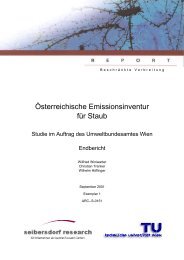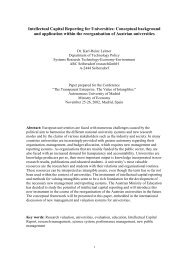ALPMON FINAL REPORT - ARC systems research
ALPMON FINAL REPORT - ARC systems research
ALPMON FINAL REPORT - ARC systems research
You also want an ePaper? Increase the reach of your titles
YUMPU automatically turns print PDFs into web optimized ePapers that Google loves.
Contract ENV4-CT96-0359 <strong>ALPMON</strong><br />
3.1.1 Number and accuracy of parameters<br />
The assessment of the results against the success criteria should be performed by the following<br />
measures:<br />
� Accuracy levels obtained by means of remote sensing methods compared to customer<br />
requirements (taking into account tolerance ranges defined by the customer).<br />
� Accuracy levels obtained by means of remote sensing methods compared to those obtained by<br />
conventional techniques (as far as available).<br />
� Results of remote sensing techniques compared with conventional methods currently used by the<br />
customer.<br />
For all applications on national level respectively test sites the number and accuracy of parameters as<br />
required by the customer vs. the parameters derived by means of remote sensing for <strong>ALPMON</strong> are<br />
compared in Annex 6. Therefore, they are not discussed in detail here. As far as applicable, the remote<br />
sensing approach is also compared to conventional methods. It has to be stated that in most cases no<br />
conventional methods, such as aerial photo interpretation or field work, have been used by the<br />
customer before – especially not for the entire area to be investigated. Therefore, a comparison in<br />
most cases was not possible.<br />
As the land use classes required for the data base of the Alpine Convention are not as detailed as<br />
those obtained for the national applications, it can be stated that these parameters could be acquired<br />
with good spatial as well as thematic accuracy. The second requirement of the Alpine Convention, the<br />
assessment of vegetation damage, could not be fulfilled within the <strong>ALPMON</strong> project. Forest damage<br />
has been investigated in more detail in the EC-project SEMEFOR (ENV4-CT97-0398), and methods<br />
for deriving this parameter were deduced from there. Furthermore, the assessment of the succession<br />
status was of interest for the AC. This parameter can easily be deduced from comparison of the land<br />
cover classification results, as they were derived in the <strong>ALPMON</strong> project, from different years by<br />
monitoring techniques. A method for vegetation monitoring in the Alps has been developed by Gallaun<br />
et al. (1999), which can be applied to the monitoring of succession status. Mono-temporally, the<br />
satellite image classification can only give information on the actual vegetation cover, but not on<br />
succession, which is a process of several years. Finally, topographical information, which is at least a<br />
pre-requisite for satellite image pre-processing, in all test sites was provided by means of digital<br />
elevation models. Quality and resolution of the DEM in all cases are sufficient for the Alpine<br />
Convention. As no high resolution DEM (25m) is available for the entire Alps, it could even be<br />
considered to introduce the MONA DEM with 80m resolution to the AC data base.<br />
Concluding it can be stated, that in many cases the customer requirements could be fulfilled. In some<br />
feasibility studies, some parameters required by the customers could not be extracted from remote<br />
sensing data or not with sufficient accuracy. However, even in these cases, the results derived from<br />
earth observation data represent a valuable information source which significantly improves the actual<br />
sate of available information for the customers. With respect to the new very high resolution satellite<br />
data this positive effect is expected to be even increasing, as the classification of some parameters<br />
was restricted due to the coarse resolution of the satellite data available for this study.<br />
3.1.2 Cost estimation<br />
Not only the potential of satellite imagery to derive certain land cover parameters, but also the costs of<br />
such an approach are decisive for the decision of various customers to introduce earth observation<br />
methods into their specific applications. With this respect, the costs for the remote sensing approach<br />
were estimated and compared to the costs of conventional methods (as far as applicable).<br />
The cost estimation has been performed for three different investigation scales:<br />
� Scale 1:250,000 (with respect to the Alpine Convention, using WIFS data): forest/non-forest and<br />
forest type<br />
� Scale 1:50,000 to 1:100,000 (with respect to the Alpine Convention, using Landsat 7 TM data):<br />
Alpine Convention nomenclature<br />
� Scale 1:50,000 and better (with respect to the national customers; with additional parameters<br />
relevant for these customers; on the assumption that higher resolution data is used).<br />
The cost estimation for the national applications with a scale of 1:50.000 or better is given in Table 14<br />
(in EURO) and Table 15 (in person hours). The figures concerning the person hours do not consider<br />
JR, RSDE, ALU, LMU, Seibersdorf, WSL 65




